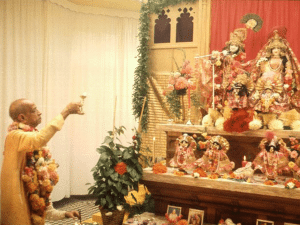Deity Worship: important limb of devotional service
Kurma Dasa: When the devotees had acquired the temple at La Cienega Boulevard in Los-Angeles in October 1968, Prabhupada had announced: Now we will begin full-scale Deity worship. He talked of beginning something new in ISKCON, the daily offerings of prasadam and daily aratis to the temple Deity, as was done in the great Vaishnava temples of India. Prabhupada had explained that although chanting the Hare Krishna mantra was sufficient in itself for going back to Godhead, Deity worship was one of the five important limbs of devotional service. Since people in Kali-yuga are restless, Deity worship was recommended for their purification. Prabhupada had turned to some of his women disciples who seemed particularly inclined and instructed them how to sew ornate dresses for the Deity, decorate the altar and cook for the Deity.
By the time the ISKCON world headquarters had been established at the new Los Angeles temple in Watseka Avenue on the appearance day of Srila Bhaktisiddhanta Sarasvati in February 1970, Deity worship was in full swing.The pujari, or temple priest, woke the Deity, or arca-vigraha, early in the morning and the first arati, mangala arati, was held one-and-a-half hours before sunrise, after an offering of milk sweets. At arati, the pujari would consecutively offer in clockwise circles before the Deity, burning incense, lamps, water in a conchshell, a clean handkerchief, fragrant flowers, a yak-tail whisk and a peacock feather fan, while ringing a bell in his left hand. Similar aratis were performed throughout the day, after offerings of carefully prepared foodstuffs.The devotees took the remnants of those offerings as the Deities' prasadam. At night, the Deities were put to rest. Prabhupada had insisted the devotees understand that the arca-vigraha is actually the Lord and proprietor of the temple, stressing that the devotees should serve Him, just as a king is served in his palace. Srila Prabhupada added a salutary warning. If the devotees enthusiasm to worship the Deity waned, offences would be committed. Under those circumstances, the temple worship might appear like drudgery, even idol worship. If however, they worshiped sincerely, Prabhupada added, then worship of the Lord in arca-vigraha form would naturally increase their Krishna consciousness.
When the first Australian temple had opened in Potts Point, Deity worship had, apart from kirtana, simply amounted to offering incense and whatever food was cooked. This offering was done on a very basic altar before a picture of Srila Prabhupada and Lord Caitanya. At Bondi, a small set of Deities of Lord Jagannatha, Balarama and Subhadra had been mounted on a small altar as an addition, and offerings of lamps and flowers were now included. When they heard all the latest developments in Los Angeles, the Sydney devotees realised that they had a long way to go. All the same, Prabhupada wanted that all of the temples come up to the same standard as Los Angeles.
One day Bali-mardana received a letter from Srila Prabhupada:
At the present moment, I am concentrating my energy in this Los Angeles centre as the ideal for all other centres, in respect of Deity Worship, Arati, Kirtana and other necessary paraphernalia. As I have curtailed my moving program, I wish that you may come here at your convenience and stay here for a few days and see personally how things are going on, and by meeting with me personally for necessary instruction, I hope simultaneously in all centres that activities be of the same standard.
Under the guidance of Tirthapada, the Sydney devotees built an improved altar and introduced some simple new standards. They sent photographs to Srila Prabhupada who wrote back: I have seen some pictures from your side. It appears that the altar is very nicely made. Prabhupada assured them that as they tried to improve things in Australia, Krishna would give them all facilities.
Reference: The Great Transcendental Adventure by Kurma Dasa
Recently Added
Trending Today
